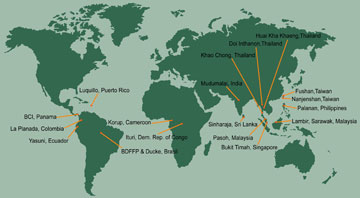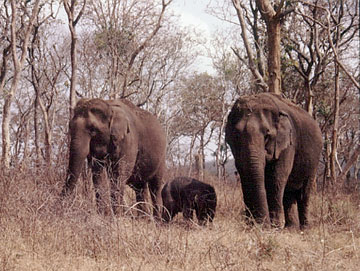http://news.mongabay.com/2006/0126-forests.html
Mother nature encourages diversity in rainforest trees
Rhett A. Butler, mongabay.com
January 26, 2006
Older forests have a greater diversity of trees than younger forests according to research published in Friday's issue of the journal Science. The study — conducted by 33 ecologists from 12 countries — found that nature encourages diversity by selecting for less common trees as the trees mature, indicating that diversity has ecological importance to tropical forests.
"Ecologists have debated for decades over whether there is something of ecological value to species diversity," said Christopher Wills, a University of California at San Diego biology professor who is lead author of the study. "We found that in forests throughout the New and Old World tropics, older trees are more diverse than younger ones. In other words, diversity is actually selected for as each of the forests matures. This means diversity does indeed matter and is an essential property of these complex ecosystems."
The study was conducted on seven undisturbed tropical forest plots maintained and studied by research institutions in Borneo, India, Malaysia, Panama, Puerto Rico and Thailand, under the coordination of the Center for Tropical Forest Science of the Smithsonian Tropical Research Institute (STRI), based in Panama.
"The great scientific value of these tropical forest observatories is that each of them has undergone a complete census more than once, so that the researchers know what has happened to hundreds of thousands of trees from one census to the next," says Stuart Davies, the director of the Center for Tropical Forest Science at STRI. "These tropical forest observatories, along with others in our network, represent some of the most important, detailed and long-running ecological studies in the world today."
 Map of Center for Tropical Forest Science permanent study sites
Map of Center for Tropical Forest Science permanent study sites
Related articles
Study uncovers how thousands of tree species coexist in rain forest
A group of scientists have a developed a new theory to explain why the biodiversity of tropical rain forests is so high and how species are assembled in an ecological community. According to their research presented in Nature, the answer can be found in "neutral theory" whereby community membership is determined by just five fundamental processes. The scientists say that species will regulate themselves to make room for each other if they follow the "membership rules." The new theory undermines the conventional "niche theory" which has been traditionally used to explain community assemblages.
Birds and Bats Responsible for Seed Dispersal in Tropical Forests
Scientists believe they may have found a way to regrow tropical forest on deforested lands. The plan would involve planting fast-growing, fruit-producing trees, like figs, in the formerly forested areas. These trees would attract birds and bats which would deposit seeds from nearby forests onto the ground below. The dropping of these seeds would, in effect, return native forest species to the deforested patch. Scientists will test the theory in Veracruz, Mexico to see if coaxing birds and bats back into the area will help restore the forest's biodiversity.
The study found that all the monitored forests showed the same pattern of increasing local diversity as trees age even across variable forest types from tropical rainforest to drier, open forest.
"Each forest in our study is a highly dynamic community," says Kyle Harms, a Louisiana State University professor of biology who collaborated on the project. "We found that the diversity of each local area increased regardless of the species that were present. This is because trees that were locally common tended to die more often than those that were locally rare, giving a survival advantage to rare species." The effect was even seen within species, he adds. "If a species was common in one part of a plot and rare in another, its death rate was higher where it was common."
While the study uncovered patterns of diversity among tree species in tropical forests, the exact mechanism responsible for this diversity remains unknown.
In a news release announcing the research, the authors cite three possibilities, all of which are likely to play a role:
 Fires and elephants are the greatest source of mortality to trees at the Mudumalai study site. Photo courtesy of STRI photo archives
Fires and elephants are the greatest source of mortality to trees at the Mudumalai study site. Photo courtesy of STRI photo archives
The authors note that these diversity-enhancing processes are generally absent from "monoculture" tree plantations and forests that have been badly damaged by logging or fire. The researchers say that when forests are cleared, soils are rapidly eroded and leached of nutrients, while symbiotic microorganisms, insects and fungi are lost, making it difficult for tree diversity to be re-established. However, note the authors, in forests that have been carefully logged using selective logging techniques, ecosystems can quickly regain former levels of diversity.
Mother nature encourages diversity in rainforest trees
Rhett A. Butler, mongabay.com
January 26, 2006
Older forests have a greater diversity of trees than younger forests according to research published in Friday's issue of the journal Science. The study — conducted by 33 ecologists from 12 countries — found that nature encourages diversity by selecting for less common trees as the trees mature, indicating that diversity has ecological importance to tropical forests.
"Ecologists have debated for decades over whether there is something of ecological value to species diversity," said Christopher Wills, a University of California at San Diego biology professor who is lead author of the study. "We found that in forests throughout the New and Old World tropics, older trees are more diverse than younger ones. In other words, diversity is actually selected for as each of the forests matures. This means diversity does indeed matter and is an essential property of these complex ecosystems."
The study was conducted on seven undisturbed tropical forest plots maintained and studied by research institutions in Borneo, India, Malaysia, Panama, Puerto Rico and Thailand, under the coordination of the Center for Tropical Forest Science of the Smithsonian Tropical Research Institute (STRI), based in Panama.
"The great scientific value of these tropical forest observatories is that each of them has undergone a complete census more than once, so that the researchers know what has happened to hundreds of thousands of trees from one census to the next," says Stuart Davies, the director of the Center for Tropical Forest Science at STRI. "These tropical forest observatories, along with others in our network, represent some of the most important, detailed and long-running ecological studies in the world today."
 Map of Center for Tropical Forest Science permanent study sites
Map of Center for Tropical Forest Science permanent study sitesRelated articles
Study uncovers how thousands of tree species coexist in rain forest
A group of scientists have a developed a new theory to explain why the biodiversity of tropical rain forests is so high and how species are assembled in an ecological community. According to their research presented in Nature, the answer can be found in "neutral theory" whereby community membership is determined by just five fundamental processes. The scientists say that species will regulate themselves to make room for each other if they follow the "membership rules." The new theory undermines the conventional "niche theory" which has been traditionally used to explain community assemblages.
Birds and Bats Responsible for Seed Dispersal in Tropical Forests
Scientists believe they may have found a way to regrow tropical forest on deforested lands. The plan would involve planting fast-growing, fruit-producing trees, like figs, in the formerly forested areas. These trees would attract birds and bats which would deposit seeds from nearby forests onto the ground below. The dropping of these seeds would, in effect, return native forest species to the deforested patch. Scientists will test the theory in Veracruz, Mexico to see if coaxing birds and bats back into the area will help restore the forest's biodiversity.
The study found that all the monitored forests showed the same pattern of increasing local diversity as trees age even across variable forest types from tropical rainforest to drier, open forest.
"Each forest in our study is a highly dynamic community," says Kyle Harms, a Louisiana State University professor of biology who collaborated on the project. "We found that the diversity of each local area increased regardless of the species that were present. This is because trees that were locally common tended to die more often than those that were locally rare, giving a survival advantage to rare species." The effect was even seen within species, he adds. "If a species was common in one part of a plot and rare in another, its death rate was higher where it was common."
While the study uncovered patterns of diversity among tree species in tropical forests, the exact mechanism responsible for this diversity remains unknown.
In a news release announcing the research, the authors cite three possibilities, all of which are likely to play a role:
- First, rare species may be at an advantage because the animals, fungi, bacteria and viruses that prey on them are less likely to cause damage when their hosts are rare. Second, the rare species may be at an advantage in competition for certain physical resources, because individuals of the same species tend to share more similar resource requirements than individuals of different species. And third, rare species would be at an advantage when tree species have direct, positive influences on one another, because trees of rare species are on average surrounded by a high proportion of trees that are different from themselves.
 Fires and elephants are the greatest source of mortality to trees at the Mudumalai study site. Photo courtesy of STRI photo archives
Fires and elephants are the greatest source of mortality to trees at the Mudumalai study site. Photo courtesy of STRI photo archives The authors note that these diversity-enhancing processes are generally absent from "monoculture" tree plantations and forests that have been badly damaged by logging or fire. The researchers say that when forests are cleared, soils are rapidly eroded and leached of nutrients, while symbiotic microorganisms, insects and fungi are lost, making it difficult for tree diversity to be re-established. However, note the authors, in forests that have been carefully logged using selective logging techniques, ecosystems can quickly regain former levels of diversity.

